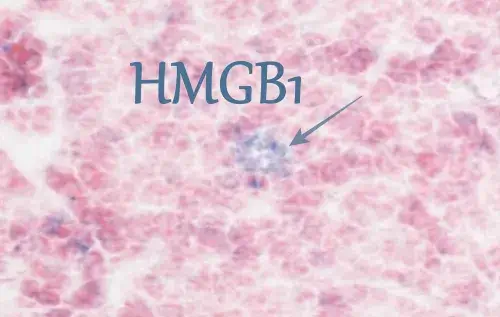Aging Therapy. Imagine a world where aging isn’t an inevitable biological process but rather a contagious condition, spreading from cell to cell like a slow-moving fire. It sounds like something straight out of a science fiction novel, right?
Yet, new research suggests this hypothesis might have a scientific basis. Scientists have discovered that aging could be transmitted throughout the body by a specific protein that acts as an infectious signal.
This groundbreaking discovery completely changes our understanding of the mechanisms of aging and opens the door to the development of new, revolutionary anti-aging therapies.
The Culprit of Cellular Aging Therapy.
The HMGB1 Protein.
At the heart of this discovery lies a molecule known as HMGB1 (High-mobility group box 1). Normally, this protein resides in the cell’s nucleus, where it helps organize DNA and ensures normal cellular function. However, when a cell ages or is subjected to stress, HMGB1 is expelled from it.
This is where things get truly interesting.
Scientists have found that HMGB1 can exist in two states: an oxidized form and a reduced form. The oxidized form is harmless, but in its reduced state, HMGB1 becomes an “aging messenger” that activates inflammatory processes and promotes degenerative changes in other cells.
This means that it’s not the mere presence of the HMGB1 protein that matters, but its specific chemical state. Researchers at Korea University proved that only the reduced form of HMGB1 can trigger cellular aging, while the oxidized variant is completely benign.
This finding is a paradigm shift, moving the focus from the presence of a molecule to its specific form and function in the aging process.
To test this theory, researchers treated human lung, skin, kidney, and muscle cells in a laboratory setting with the reduced form of HMGB1. The results were alarming: within days, the cells stopped dividing, activated aging genes (such as p21 and p16), and began releasing pro-inflammatory molecules.
This behavior is characteristic of cellular senescence, a state where cells stop functioning normally but do not die. They essentially become “zombie cells,” stuck between life and death, constantly releasing harmful signals that damage surrounding tissues.
In stark contrast, cells treated with oxidized HMGB1 maintained normal activity and continued to divide without any signs of aging.
This experiment convincingly demonstrated that senescent cells, by releasing the active form of HMGB1, can “infect” healthy cells, causing them to exhibit the same signs of aging.
This creates a dangerous feedback loop: the more senescent cells there are, the more HMGB1 protein is released, and the faster other cells age.
This discovery redefines our understanding of aging, showing that it is not merely a localized wear-and-tear process but a dynamic, transmissible process driven by chemical signals.
Can Aging Be Stopped With Medicine?
To confirm the significance of these results in a living organism, researchers injected the reduced HMGB1 protein into young mice. Within a week, the mice showed signs of aging: their muscle function deteriorated, inflammation increased, and senescence markers were activated in their tissues.
In another experiment, older mice with muscle injuries were injected with antibodies that block the action of HMGB1. The results were impressive: wounds healed faster, inflammation decreased, and the mice’s physical endurance improved—they ran better and their paws had a stronger grip.
These findings open up vast possibilities for the development of new anti-aging drugs that could block the active form of HMGB1, convert it into its inactive oxidized form, or inhibit the activation of the inflammatory pathways it triggers.
Interestingly, some of these drugs already exist and are used to treat autoimmune diseases. Now, they could find a new application in the fight against aging. When combined with other anti-aging medications, they could prove to be particularly effective.
The Future of Longevity.
Beyond Caloric Restriction.
Aging remains one of the leading causes of mortality and declining quality of life. Scientists worldwide are actively working to develop methods that not only extend life but also improve its quality in old age.
Slowing down the aging process, even for a short period, could reduce the prevalence of diseases such as diabetes, cardiovascular pathologies, and neurodegenerative disorders.
While slowing down aging may seem like science fiction, it is theoretically possible. For years, scientific research has confirmed that reduced caloric intake, while maintaining adequate nutrient levels, can slow aging and extend life.
This effect has been observed in various species, including mice, monkeys, and even humans.
However, this method has significant drawbacks: not everyone can tolerate long-term dietary restrictions, and side effects such as a weakened immune system, hair loss, and a decline in bone density make it an unattractive option for many.
However, if it were possible to activate the same mechanisms that arise from caloric restriction but without reducing nutrients, the aging process could theoretically be slowed down. It appears that such an effect can be achieved with a simple blood pressure medication.
Recent studies suggest that the popular medication Rilmenidine can produce precisely this effect. It activates the same cellular mechanisms as caloric restriction but without the stress of starvation.
When studying this drug in worms, scientists observed that Rilmenidine significantly extended the worms’ lifespan and improved indicators such as motor activity and stress resistance.
However, despite these encouraging results, research on Rilmenidine is only just beginning. Widespread clinical trials with humans are needed before this medication can be directly applied in the fight against aging.
A New Hope for a Healthier Future.
These discoveries suggest that aging is not merely a genetic program or the wear and tear of tissues but a dynamic, potentially reversible process involving biochemical signals. This means that aging is more cunning than previously thought.
It’s not a simple depletion of cells but an active chemical signal that can spread between tissues.
However, in this threat also lies hope: if this signal can be blocked, aging can be slowed and, possibly, even stopped. New research and clinical trials will show whether humans will one day be able to “vaccinate” against aging and enjoy life without its limitations.
The changing understanding of aging offers hope that in the future, we will not only be able to live longer but also healthier and more fulfilling lives.
Have a Great Day!





